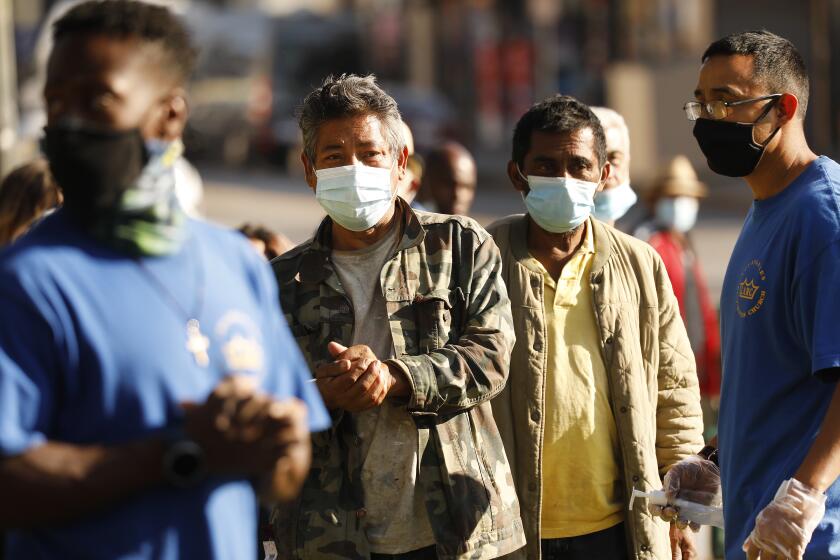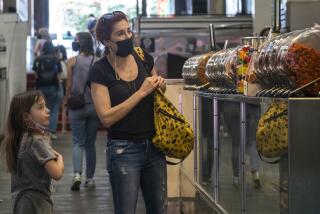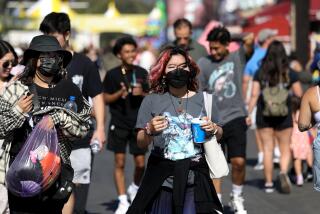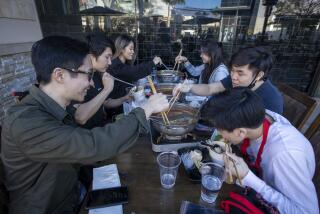New L.A. County ‘Safer at Home’ restrictions revealed as COVID-19 surge worsens
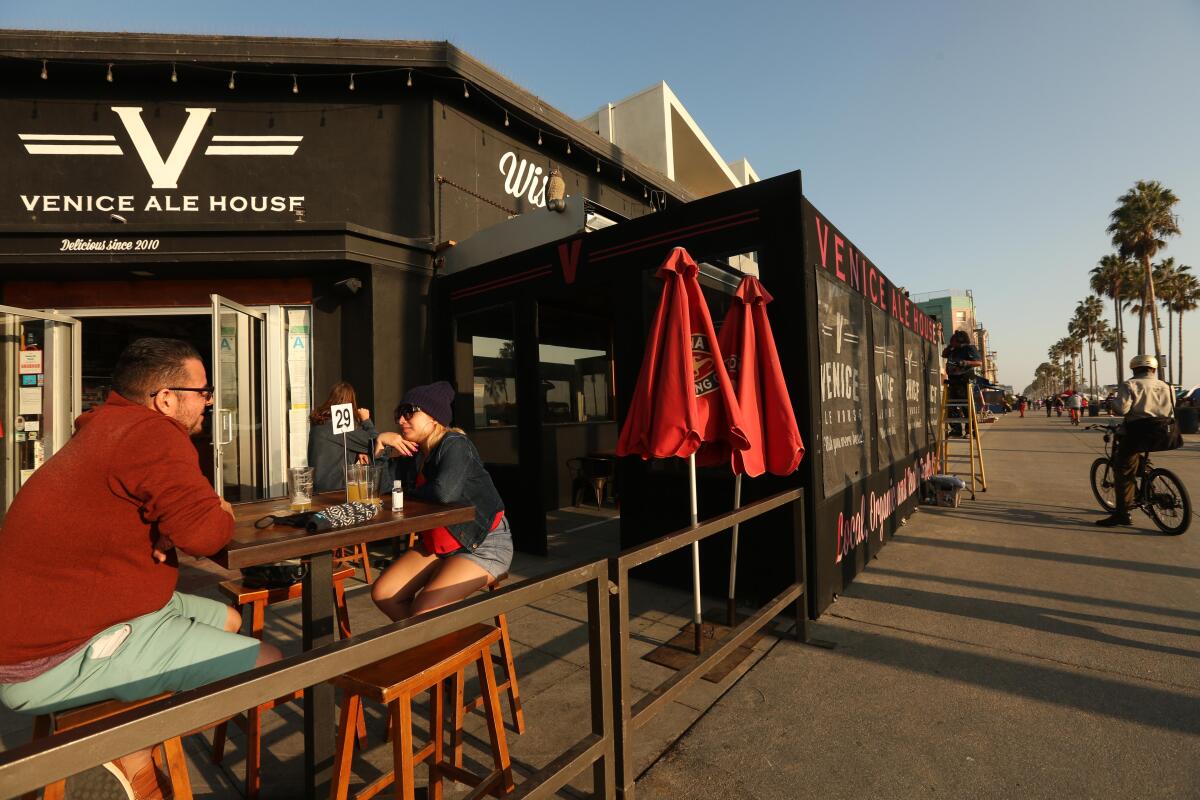
- Share via
With coronavirus cases and COVID-19 deaths surging at an alarming rate, Los Angeles County officials Tuesday began to outline a new limited Safer at Home order aimed at slowing the virus spread while sticking with an outdoor dining ban amid a growing outcry.
The new restrictions are looking increasingly likely as daily coronavirus infections spike to unprecedented levels, increasing stress on hospitals amid concern more people will be infected during the Thanksgiving holiday. But it also appears that a new stay-at-home order that had been suggested as a possibility last week would fall far short of the one imposed during the first months of the pandemic in the spring.
The March order closed all but essential businesses and left many people at home except for trips to such places as supermarkets and medical offices. But officials suggested Tuesday the new rules would allow many businesses to remain open but with limited customer capacity. More details might be provided today.
Gov. Gavin Newsom has announced a stay-at-home order affecting most of California.
“We are not completely shutting down everything,” said Los Angeles County Supervisor Hilda Solis.
“Nonessential businesses will be very much open; gyms will be open outdoors; zoos will be open; hair salons; mini-golf and go-karts will be open with reduced capacity,” supervisor Janice Hahn said.
The proposed directives are all designed to keep people in their homes as much as possible, reduce capacity at sites where people from different households interact with each other, and curtail some nonessential activities.
They include:
- A ban on all gatherings among people who don’t live in the same household, with exceptions for outdoor church services and outdoor protests. Currently, small gatherings are allowed outdoors, but capped at up to 15 people with no more than three households allowed.
- A reduction in occupancy of essential retail stores to 35% of capacity; for grocery stores, that would be a reduction from the current cap of 50% capacity.
- A reduction in capacity at nonessential retail stores and libraries to 20%; currently, they can hold up to 25% of capacity.
- The ordered closure of playgrounds that are not part of a school or child-care center; swimming pools that serve members of more than one household, although regulated lap swimming can continue; and card rooms.
Beaches, trails and parks would remain open, as would outdoor venues like golf courses, tennis courts, skate parks, and community gardens.
The latest maps and charts on the spread of COVID-19 in Los Angeles County, including cases, deaths, closures and restrictions.
Child-care and day care, schools and day camps that have opened under current protocols would be able to remain open as is the case under existing rules, with one new requirement: an ordered closure for 14 days should an outbreak occur, which is defined as three or more cases over a two-week period.
Activities that can continue include professional sports without spectators and outdoor youth sports for conditioning and skill building only; tournaments and competitions have not been allowed to resume.
And the county would still need to abide by the state’s limited overnight stay-at-home order, which says nonessential activities outside the home with members of other households must end between 10 p.m. and 5 a.m.
It was only a week ago that county officials raised the prospect of a new stay-at-home order, which they said would only generally allow essential workers and people securing essential services to leave their homes.
But since then, the Los Angeles County director of public health, Barbara Ferrer, said a sweeping shutdown is not necessary because the county has more tools to handle COVID-19 compared with the spring, when less was known about the disease. “We have much more capacity on testing now, which allows us to do a better job quickly identifying people who are positive,” Ferrer said.
“We’ve learned some things from that previous time,” said Dr. Muntu Davis, the L.A. County health officer. “There were certain things that we didn’t have in place, in terms of universal face covering.”
Officials did not elaborate on the timing of the new order. But conditions were continuing to deteriorate. On Tuesday, 45 additional deaths were reported in L.A. County, the highest single-day total since early September. The deaths of L.A. County residents are now reported at triple the daily rate they were on Nov. 3.
Hospitalizations were also climbing at rapid rates, with nearly 1,700 people in the hospital with COVID-19 on Tuesday, up from nearly 800 on Oct. 23. Officials warned that unless county residents change their behavior on a widespread scale, the existing supply of staffed hospital beds will soon be exhausted.
The new wave of coronavirus cases brings L.A. County closer to another stay-at-home order.
While L.A. County has been particularly hard hit, the state as a whole is wrestling with an avalanche of coronavirus cases, and officials expect the number of daily deaths will become even worse than the summer peak.
“Certainly, the numbers of deaths will likely go up. Just as we are exceeding our highest-ever numbers of cases, and beginning to see our hospital systems pressed with COVID beyond where they’ve ever been pressed before, the idea that the numbers of deaths could exceed where we’ve been before is also real and true,” Dr. Mark Ghaly, the California health and human services secretary, said Tuesday.
The state recorded 20,654 cases Monday, shattering the previous single-day record of 13,412 infections, according to an independent Times survey of California counties. L.A. County recorded nearly 6,200 cases Monday, which was also a daily record, and more than 3,700 on Tuesday.
“We are truly in the midst of a surge here in California,” Ghaly said.
Statewide, the daily average of new coronavirus cases, calculated over a seven-day period, more than doubled in the past two weeks, a Times analysis found. Most of California’s counties also reported the same doubling or worse.
Imperial County has seen its daily average of coronavirus cases nearly quadruple in the last two weeks. That county has been forced to erect a 50-bed tent to help deal with a surge in COVID-19 patients and has requested dozens of additional healthcare workers, including 33 intensive care unit nurses, three lab scientists, 21 emergency room nurses and six respiratory therapists, officials said last week.
Imperial County has also seen its coronavirus test positivity rate double in the course of a month, from 10.5% to 23.8%.
Between Nov. 1 and Monday, the number of people hospitalized with COVID-19 statewide has more than doubled, Ghaly said, from about 2,500 to more than 5,800. Some hospitals’ intensive care units “are already being pressed to a significant degree,” he added.
Gov. Gavin Newsom has announced a stay-at-home order affecting most of California.
“When you see the numbers more than double in just under three weeks, we’re concerned,” Ghaly said.
Los Angeles County health leaders have made the same point, saying they worry cases could spike much more after the Thanksgiving holiday.
But their efforts to restrict movements are meeting with growing backlash. The suspension of outdoor restaurant dining was met with anger and desperation from restaurateurs, who have been reeling from the shutdown. Outdoor dining offered a lifeline, and many owners and workers felt they were doing everything they could to keep their establishments safe.
Others questioned the wisdom or efficacy of the restriction, and demanded to see the data justifying such a move.
A divided Los Angeles County Board of Supervisors rejected calls Tuesday to walk back the ban on in-person outdoor dining and restrict restaurants — along with breweries and wineries — just to takeout and delivery service beginning at 10 p.m. Wednesday.
Supervisor Kathryn Barger, whose district includes Santa Clarita, much of north L.A. County and the northern San Gabriel Valley, said the suspension “will punish a sector that is unfairly shouldering the burden” — and added that she’s “concerned that this county has taken the approach of everything should be closed, unless we have a good reason to open it.”
“I feel that what is happening today is truly going to devastate not only the workers but their families,” Barger said.
Barger and Hahn voted to block the ban. But the board majority was swayed after county health officials said it was clear that people gathering with others outside their immediate families and removing their masks to eat increased the risk of new infections.
Out-of-state travelers arriving at LAX, Van Nuys airport and Union Station must sign a form acknowledging the county’s COVID quarantine.
“This is the only business that allows its customers to remain, and often for quite a while, unmasked,” said Supervisor Sheila Kuehl, who represents parts of the Westside, the San Fernando Valley and Malibu. “And that, I think, is enough to single it out right there. We tried, but the numbers have gone up.”
Solis, who represents East L.A., southeast L.A. County and parts of the San Gabriel Valley, said she was at a private hospital over the weekend because her mother had a health issue and was alarmed at what she saw.
“I’ve never in my life seen the corridors in the ER completely full,” Solis said. “There were no rooms available to treat COVID patients. That to me was very startling.”
The 3-to-2 board vote to go forward with the restrictions came shortly after the Los Angeles City Council voted 11 to 3 Tuesday to seek a repeal of the outdoor dining restrictions. The vote amounted to a recommendation because the city is generally governed by the county’s public health rules.
“This will be the final nail in their coffin,” said Councilwoman Monica Rodriguez of local restaurants.
Councilman Mike Bonin, who cast a dissenting vote along with members Marqueece Harris-Dawson and Curren Price, said some restaurants have set up outdoor dining areas with barriers so significant that their patrons are effectively experiencing indoor dining. He also argued that the council, which lacks its own health department, does not have a team of experts to guide them on their decision.
“Since we don’t have the scientists … I would prefer to think that we would defer to the county, which is in charge of the issue,” he said.
The California Restaurant Assn. filed a lawsuit challenging the ban by county health officials and sought an emergency order from a judge halting the new rules from taking effect.
Attorneys for the association asked Judge James Chalfant to issue an order to stop the closures from going forward unless health officials can provide scientific evidence backing their decision to impose the dining ban. Chalfant denied the request, calling the evidence the association presented “insufficient” to overturn the ban or to require the county to provide the data in his ruling.
The judge also said that in the absence of “solid evidence” from the association showing the dining ban was inappropriate, he would not schedule further hearings to consider whether the ban should be overturned. If new evidence comes to light, Chalfant said the association is free to bring it to him.
Critics of the outdoor dining ban did claim a victory in Pasadena, which said will allow restaurants to continue outdoor dining despite the county order. The city has its own Department of Public Health that can issue independent orders, and until now had generally followed the lead of Los Angeles County.
“We will assess our data daily but at this point will not close down restaurants on Wednesday or the near future,” said Lisa Derderian, spokeswoman for the city of Pasadena.
San Francisco, which has seen its own COVID-19 case numbers surge but is still in much better shape than Los Angeles County, announced Tuesday it would keep outdoor dining open for now. Still, officials warned the virus was spreading fast. The rate at which coronavirus tests turned up positive has more than doubled in the last month. Hospitalization rates for COVID-19 in the city have doubled since the end of the month.
“This is a once-in-a-century pandemic,” said Dr. Grant Colfax, the city’s public health director. “This not the time to throw caution to the wind.”
Times staff writers Maura Dolan in San Francisco, Sean Greene in Thousand Oaks, and Ryan Menezes and David Zahniser in Los Angeles contributed to this report.
More to Read
Sign up for Essential California
The most important California stories and recommendations in your inbox every morning.
You may occasionally receive promotional content from the Los Angeles Times.


